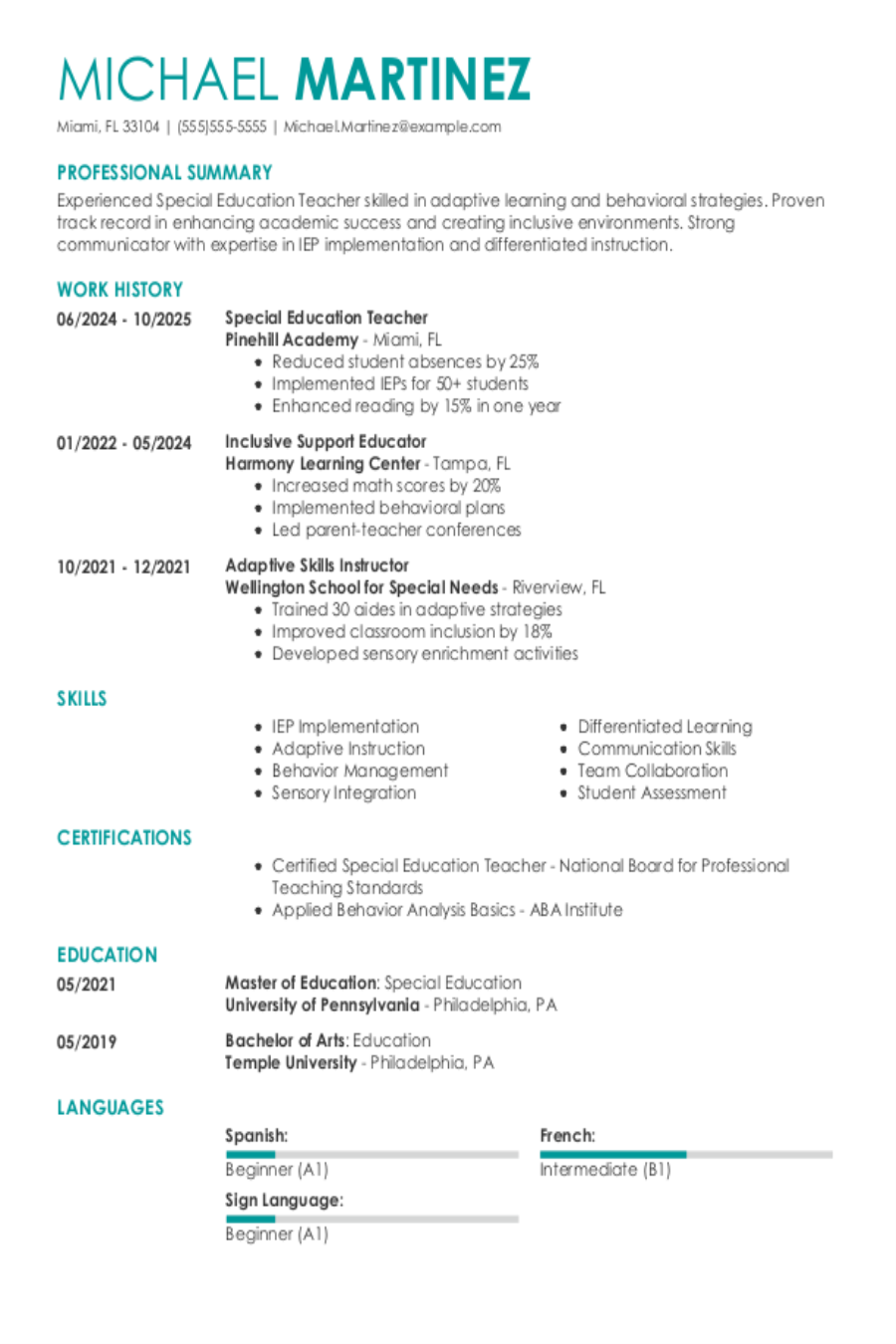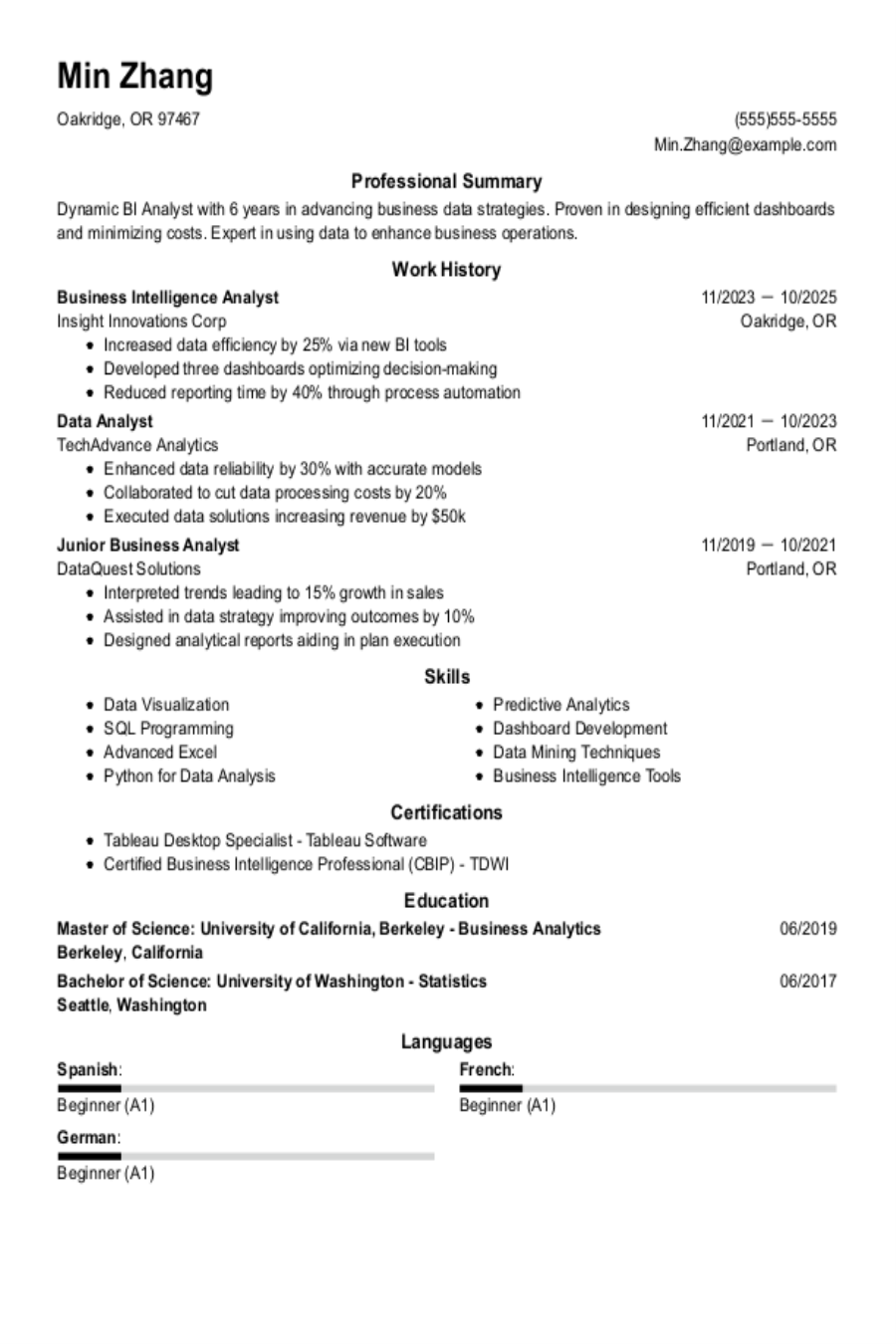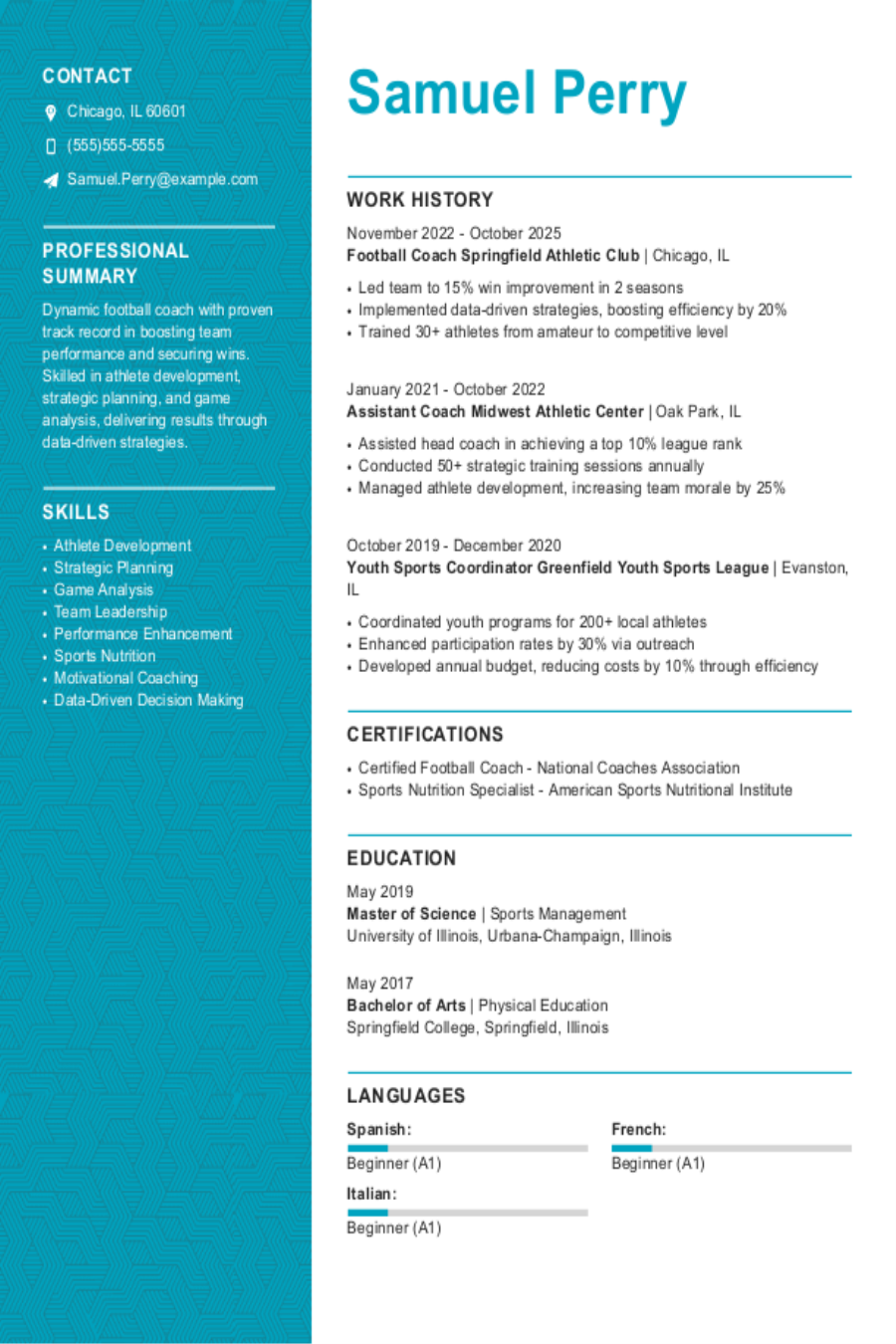Table of contents
- What to Include in Your Resume to Land Your Next Job
- Include the Right Contact Info
- Add an Attention-Grabbing Professional Summary
- Highlight Your Work Experience
- Which Skills Should You Put On Your Resume?
- How to Highlight Education on Your Resume
- Add Other Sections to Your Resume
- Bonus Step — Target Your Resume to the Job Ad
- What Not to Include on a Resume
- Key Takeaways
Landing a new role that excites you begins with creating or updating your resume to capture hiring managers’ attention. To get started, you must understand what to put on a resume to make your experience and skills stand out.
Follow this guide to learn how to write a resume that makes an impression, whether you’re an experienced professional or a first-time applicant.
In this guide we’ll cover:
- What to put on your resume to land an interview fast.
- How to target your resume for the job you’re seeking.
- What NOT to include on your resume.
- Key takeaways.
Ready to start building your resume? Try our Resume Builder for a quick and easy solution to updating or creating a unique resume that impresses recruiters.
What to Include in Your Resume to Land Your Next Job
For starters, your resume outline should include the following sections:
- Header with your contact info.
- Well-written professional summary or resume objective.
- Work experience.
- Your most relevant skills.
- Education and certifications.
- Other key sections, like languages, awards or interests.
Next, we’ll go through each of these sections one by one.
Include the Right Contact Info
Put the following contact information on your resume:
- Your full name: First name and last name will suffice.
- Your professional title: Listing the job title you’re applying for underneath your name or including your certification (for example, RN for registered nurse) is a great idea.
- Your phone number: Make sure to list the number you actually answer.
- A professional email address: Use an email address that’s completely professional.
These days, your address is considered optional. You will benefit from including your location mainly if you’re applying for a job that requires you to live in a specific city, state or country.
If you work in a creative field, you may want to add:
- A link to your website or portfolio.
- Relevant social media profiles, like LinkedIn.
Remember, the goal is to keep your resume header informative yet concise. You want to share the important details without overloading the reader with unnecessary details.
Pro tip: If you’re applying for a job outside your home country, include your country code. For example, if you have a U.S. phone number, you would add the (+1) before the 555-555-5555.
Add an Attention-Grabbing Professional Summary
Given that recruiters often spend only a few seconds scanning each resume, it’s crucial to catch their attention quickly.
You should put a resume profile on your resume. There are two types:
- Resume summaries provide a two- to three-sentence overview of your professional career, showcasing your experience and key achievements. This type best suits those with more than two years of work experience.
- Resume objectives are brief, typically two to three sentences, and focus on your goals and aspirations. They are ideal for those entering the workforce or changing careers, as they highlight your motivation and intent rather than your work history.
Resume objective statements are very well suited for a range of situations, including:
- Entry-level candidates.
- Students, including high school students.
- Scholarship applications.
- Anyone seeking an internship.
- Applicants with no work experience.
- Career changers and job seekers with career gaps.
Okay, now you might wonder how to write each of these resume profiles. Let’s take resume objectives first.
Here’s a resume objective you’d put on a marketing resume:
Recent graduate with a bachelor’s in marketing from the University of Wisconsin, eager to launch a career in digital marketing. Bringing a fresh perspective combined with hands-on experience from multiple university projects in social media strategy and content creation. Enthusiastic about applying theoretical knowledge and creativity to real-world marketing challenges, with the goal of contributing innovative ideas and strategies to a forward-thinking marketing team.
Here’s a professional summary you’d put on an IT resume:
Experienced IT project manager with 12+ years in managing complex tech projects, known for delivering on time and under budget, resulting in a 30% efficiency improvement. Expert in Agile methodologies, risk management and leading cross-functional teams. Oversaw 50+ large-scale projects, surpassing performance goals and fostering technological innovation.
For more help on writing a resume summary, try our AI Resume Summary Generator. In just a few clicks you’ll have a customizable resume summary tailored to you.
Next, we tackle one of the most important parts of a resume — work experience.
Highlight Your Work Experience
Creating the perfect resume means focusing on your experience. It’s important because employers look for proof that you can get results. This is your chance to show what you’ve achieved.
Start with your latest job and go back from there. You can do this effectively with a work history-focused format like a chronological resume. This format works best for candidates with extensive experience.
When you go back in time on your resume, think about whether each job is still relevant. It’s OK to leave out jobs that don’t matter much or to add a second page if you need more space — one to two pages is the ideal resume length.
Pro tip: There are many ways to give your resume a little more punch. You can add action words that vividly illustrate your achievements and responsibilities. Words like “orchestrated,” “spearheaded,” and “implemented” can make your experiences come alive on the page.
Use numbers and percentages to show your accomplishments
The best part of your job history is your achievements. Hiring managers like to see numbers and results, not just lists of what you did. This shows them what you can bring to their company.
Focus on things you can measure. For example, if you were writing an HR assistant resume, you could grab attention by measuring your success in your bullet points like this:
“Increased employee staying power by 15% in three years by starting a company culture program and organizing team events every quarter.”
If you don’t have numbers to share, remember that you can measure achievements in many ways. Whether it’s the amount of time you saved or how you increased your productivity, these can be represented by percentages.
Now, you may need a different approach when you don’t have work experience.
What if you don’t have work experience?
If you’re making a resume and don’t have work experience yet, don’t worry. Everyone starts somewhere. Here’s what you can do to create a strong resume for a first job:
- Use a resume format that focuses on skills more than work history. The functional resume is a good option.
- Talk about other experiences like volunteering or personal projects. You learn a lot from these, too.
- Expand your education section, especially any big projects or important things you did in school.
Ultimately, you’ll have to lean into your skills. Read on to learn how they can help even the least experienced candidates create a job-winning resume.
Which Skills Should You Put On Your Resume?
Adding the right skills to your resume will help you highlight your capabilities and strengths. The best resumes show off a mix of different skills.
Soft skills are interpersonal and behavioral abilities that help you work and communicate well with others.
Hard skills are the job-specific, teachable abilities or knowledge you have acquired through education, training, or experience. An impressive resume should showcase hard and soft skills to show employers you’re a well-rounded candidate.
Here are some soft skills you should put on your resume:
- Communication
- Teamwork
- Problem-solving
- Adaptability
Here are some hard skills you should put on your resume:
- Project management
- Data analysis
- Foreign language proficiency
- Accounting
Don’t forget computer skills — they’re important in virtually every industry in 2024. Here are a few to include on your resume:
- Microsoft Office Suite
- Basic coding (e.g., HTML/CSS)
- Social media proficiency
When deciding how to list skills on your resume, consider the job you’re applying for. You can have separate sections for different categories of skills or combine them all under a general skills section. No matter what you choose to do, be aware of the job listing and give priority to your most relevant skills.
Here’s an example of a plain skills section:
- Clearly communicates information and ideas in both written and verbal form.
- Collaborates effectively with diverse teams.
- Proficient in problem-solving.
- Skilled at managing time efficiently to meet deadlines.
- Able to adjust quickly to new environments and challenges.
- Proficient in Microsoft Office Suite (Word, Excel, PowerPoint).
Make sure your skills are represented throughout the entire document.
How to Highlight Education on Your Resume
Making your education shine on your resume is an important step toward showing your qualifications and knowledge. Let’s look at what’s relevant and what isn’t.
Here’s what to include in your education section:
- Names and locations of schools you attended.
- Degrees earned, along with any honors or awards.
- Relevant coursework or special projects that align with the job.
Pro tip: For students, recent graduates, or those crafting their first resume, placing education details near the top, just under your objective or summary and work history, is beneficial. For others, it’s more appropriate at the bottom of the resume.
Before we move on to specific case scenarios, there are a few basic principles to follow as you add your education.
Here are guidelines for putting education on your resume:
- When listing your degrees, add your latest schooling at the top and work backward. It’s like telling your academic story in rewind.
- If you’ve got a university degree, you can skip mentioning high school.
- Got a GPA that’s 3.5 or higher? Flaunt it! If it’s lower, there’s no need to include it.
But how should you handle education when you haven’t finished?
How do I put incomplete education on my resume?
If your study area is irrelevant to the job, you may skip it. But if it’s related or the job requires some level of education, include it.
Tips for listing an unfinished degree:
- Mention the university’s name and location.
- Include your GPA if it’s over 3.5.
- Describe the focus of your studies.
- Note the number of credits completed and any awards.
- If you’re still studying, add an expected completion date (Month and Year).
Should I include certifications?
Yes! You should put certifications on your resume. However, they may be best suited for their own section.
Tips for listing certifications:
- Create a “Certifications” section if you have relevant certifications.
- List the certificate name and the year you completed it.
- Include the issuing organization.
- Add as many entries as applicable.
Now that we’ve completed the required resume sections, let’s examine some optional ways to make your resume stand out.
Add Other Sections to Your Resume
Your resume should be as unique as you are. If you’ve got some cool experiences that don’t fit the usual categories, don’t hesitate to display your qualifications. Just make sure they’re things the hiring manager will find relevant for the job you’re after. Your weekly board game night? Maybe not so much.
Here are some extra sections you might want to add:
- Volunteer work: If you’ve volunteered a lot, treat it like a job in your work experience. Or, make a special section for it with the organization’s name, what you did, and when.
- Awards and honors: Got some trophies or awards? Add an awards section to show them off.
- Hobbies and interests: Only include these if they’re really interesting or relevant to the job.
- Special projects: Been involved in a big, exciting project? Add it to your resume.
- Certifications and licenses: Got extra qualifications? Make a section for them.
- Publications: If you’ve been published and it’s relevant to your job, list them under their own section. (This section is usually more relevant on an academic CV than a resume).
- Languages: Speak another language? Definitely worth mentioning.
- Professional affiliations: Part of any professional groups or clubs? Add them.
- Workshops: Attended any workshops that expanded your skill set? Include them.
- Conferences and seminars: Participation in relevant industry conferences and seminars can show you’re committed to your profession.
- Presentations: Given any talks or presentations? They deserve a spot too.
Remember, these extra bits are like cherries on top — they make your resume even tastier.
By the way, if you need to list references, keep them on a separate page for later. Title it “Professional References,” include people who can vouch for you, their job titles, where they work, and how to contact them. No need to add “References Available Upon Request” to your resume. That’s generally considered an out-of-date practice.
Keep reading to find out the one last thing you should put on your resume.
Bonus Step — Target Your Resume to the Job Ad
In a tough job market, you need a resume that’s made just for the job you want. A targeted resume helps you stay competitive and shows employers how well you fit their needs.
It’s best to make sure your resume matches the job you’re applying for. But, be true to what you can do. If the job needs someone good at math and that’s not your strong point, show off the skills you do have that fit the job.
This isn’t just a small thing. Many companies use applicant tracking systems (ATS) that filter for qualified candidates by scanning their resumes for key phrases that match the needs of the job. You might not get noticed if your resume doesn’t have these words. Build an ATS-friendly resume to improve your chances.
Choose keywords from the job listing to pepper throughout your resume sections. This will help your resume stand out and feel uniquely catered for the role.
Pro tip: While creative resumes look great, some applicant tracking systems struggle with fancy resume formatting. Stick to a simple resume that is ATS compatible, avoiding tables, logos, images, graphics, and text boxes, as these can confuse the system and lead to important information being missed.
Hopefully, this has helped you decide what to include on your resume. Before we wrap up, let’s discuss what you should NOT put on your resume.
What Not to Include on a Resume
Now that you know what should be on your resume, let’s talk about a few things that shouldn’t.
Do not include the following in your contact info:
- Full home address — city and state are sufficient.
- Personal details like marital status, age or gender.
- Unprofessional email addresses.
- Zodiac sign.
Do not include the following in your professional summary:
- Personal anecdotes or life stories.
- Generic statements without specific accomplishments or skills.
- Salary expectations or job demands.
- Overused buzzwords without evidence of actual experience or achievements.
Do not include the following in your work experience:
- Jobs that have no relevance to the position you’re applying for.
- Short-term roles that don’t contribute to your overall career narrative.
- Vague descriptions that don’t clearly articulate your responsibilities and achievements.
- Overly technical jargon that might not be understood by all resume reviewers.
Do not include the following in your skills:
- Generic phrases like “hard worker” without specific examples.
- Irrelevant skills that don’t match the job requirements.
- Overemphasis on outdated skills or technologies.
- Excessive listing of basic skills that are expected in the professional world.
Do not include the following in your education:
- High school details if you have higher education qualifications.
- GPAs that are not particularly strong (generally lower than 3.5).
- Every course or workshop attended, unless strongly relevant to the job.
- Dates of attendance that might inadvertently reveal your age.
Other things you shouldn’t do on your resume:
- Don’t use an inconsistent or hard-to-read format.
- Avoid long paragraphs; use bullet points for clarity.
- Steer clear of using too many different fonts or colors.
- Don’t include personal opinions or controversial statements.
- Avoid lying or exaggerating about your qualifications or experiences.
- Don’t clutter your resume with irrelevant information.
- Avoid using acronyms or industry jargon that not everyone may understand.
- Don’t submit your resume without proofreading for grammar and spelling errors.
Finally, one of the best things you can do for your resume is to accompany it with a strong cover letter. Our Cover Letter Generator can help you build a strong letter that matches your resume.
Key Takeaways
Tailor your resume.
Customizing your resume for each job application makes you a more appealing candidate. It shows employers that you’ve put thought into how your skills align with their needs.
Highlight work experience.
Only include work history that’s relevant to the job you’re applying for. This keeps your resume focused and relevant, and it makes it easier for employers to see why you’re a good fit.
Use clear and simple language.
Avoid jargon, complex language, and long paragraphs. Clear and concise wording makes your resume more accessible to a wider range of readers.
Include a mix of skills.
Balance your technical skills with soft skills to present yourself as a well-rounded candidate. This mix shows you’re not only competent but also a good team player and adaptable.
Make contact info professional.
Keep your contact information professional and to the point. This includes using a professional email address and omitting unnecessary personal details.
Keep your education relevant.
In your education section, include only the most relevant and recent qualifications, especially if you have higher education. This makes your educational background clear.
Avoid unnecessary information.
Don’t clutter your resume with irrelevant details. This helps keep the focus on the most important information about your skills and experiences.
Was this information about What To Put On A Resume (Resume Sections To Include In 2025) helpful? Let us know!
Don is a Certified Professional Resume Writer (CPRW) with more than 10 years’ experience creating digital content, including four years helping job seekers develop their careers. He holds an M.S. in Journalism from Northwestern University.
More resources

What If No One Responds When You Try To Follow Up After a Job Interview?
If no one responds after you try to follow up after a job inte...

How to List Adaptability Skills on Your Resume (35+ Examples, Definition & Tips to Improve)
Our adaptability skills definition and guide will help you wri...

What if I Don't Have Professional References?
Access advice on what to do if you get to the reference check ...

Teacher Resume: Examples, Templates & Tips
Need a teacher resume to help land you a role in the right cla...

Business Intelligence Analyst Resume: Examples, Templates and Tips
Our business intelligence analyst resume guide will help you j...

Football Coach Resume: Examples, Templates and Tips
Our football coach resume examples will help you create a resu...
